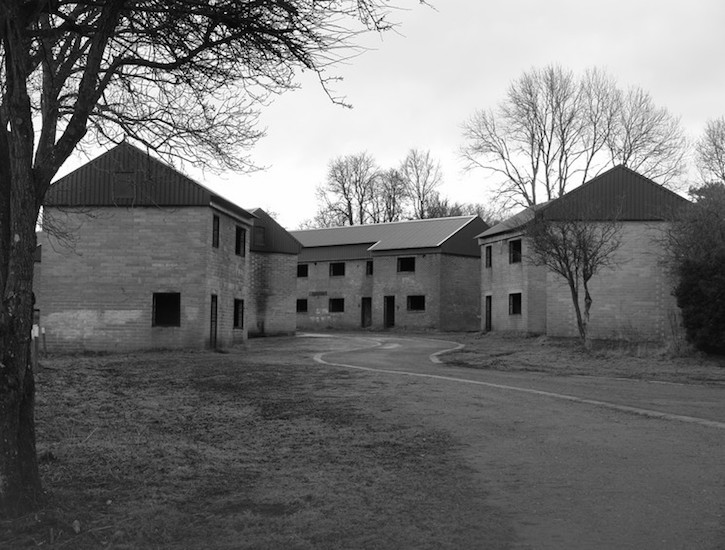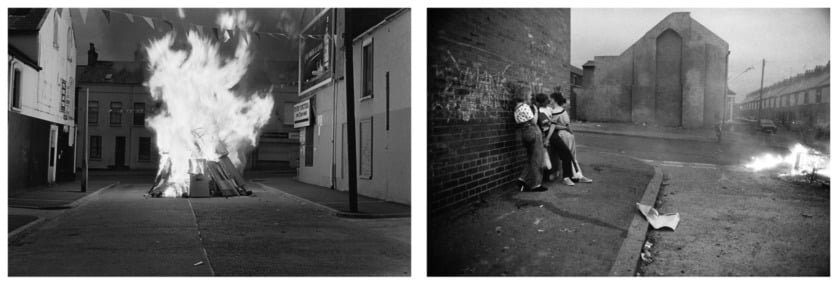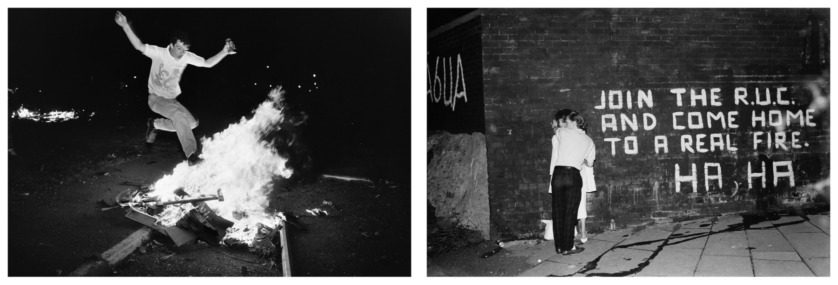Trouble Every Day

On a handful of days each year, Britain’s Ministry of Defense opens up the vast training ground it occupies on Salisbury Plain, a grassy plateau that stretches across much of the southern English county of Wiltshire. I visited a few years ago to see Imber, an ancient village evicted during the Second World War to make way for the military, its inhabitants never allowed to return. Imber’s church, constructed at the turn of the fourteenth century, was still standing, but most of the village houses had been demolished and replaced with a replica of a 1960s housing estate, of the kind you might find in Belfast. The houses were empty shells, and their brick walls were scorched black. For decades, the estate has been used to train British soldiers in urban combat ahead of deployments to Afghanistan and Iraq, as well as to Northern Ireland during the thirty-year conflict commonly known as the Troubles.
Imber feels like a good metaphor for the way Britain’s governing classes relate to Northern Ireland. An idealized rural England—the image of a green, unchanging and peaceful homeland—sits at the heart of the dominant national ideology, obscuring the messy and brutal conflict that afflicted the six counties retained by the UK after the rest of Ireland won independence in 1921. Yet the two are intimately connected. England’s wealth and stability has been assured by centuries of colonization, and its eight-hundred-year history with Ireland being among the oldest of these relationships.
These connections are often hidden from view, however, by an official culture that tends to treat Northern Ireland as a place of atavistic hatreds or irrational attachments to religion and identity. “If the Irish want to shoot each other, they will shoot each other,” Stanley Johnson, a former Conservative politician and father of the current prime minister, during a TV discussion about Brexit in 2018[1]. One of the nastiest results of this amnesia is the current right-wing backlash against prosecutions for human rights abuses committed by troops during the Troubles. The fact that some of these cases are only just making it to court now, when most soldiers are in their old age, shows how entrenched this denial is.
Looking through Gilles Peress’s Whatever You Say, Say Nothing, a collection of photographs made during the Troubles, what hit me most strongly was the constant presence of the British state. It’s not just the obvious visual cues: Union Jacks flown in loyalist communities, soldiers staking out suburban front gardens or hiding in the ditches beside country lanes. Peress’s use of repetition—scenes of celebration and violence, city street corners and country lanes, funeral rituals and street protests—urges the viewer to think about the slower-moving forces that shaped the conflict.
Peress avoids voyeurism, focusing on the everyday human aspects of the conflict.
This might not be exactly the point Peress intended, but subjective interpretation is the kind of response he consciously invites. The book, which is described as a “documentary fiction,” arranges photos he took on assignment as a member of the Magnum agency into a narrative made up of twenty-two semi-fictional “days.” By giving the material its own sense of time and movement, he suggests patterns and rhythms that a conventional historical account might miss. The suggestions are not prescriptive: readers, he said in a recent interview with his publisher, Gerhard Steidl, are as much the authors of the work as he is.
Peress took hundreds of pictures during his trips to Northern Ireland and started organizing them into a book in the 1990s, only completing the project recently. It’s worth asking what it means to be seeing these photographs for the first time in years, in some cases almost five decades after they were taken. There’s always a risk that images of war and suffering end up being exploitative. Here, though, we are being shown images at a double distance, that of time, and of the detachment that comes with a semi-fictional narrative. Peress avoids voyeurism, focusing on the everyday human aspects of the conflict. His camera dwells on faces, in all their expressions: people caught smiling, shouting or looking pensive; sometimes unaware of the camera and sometimes warily eyeing the photographer. The framing is often gently playful, accentuating the angles and straight lines of buildings and structures so that they are discordant with the individuals pictured: people making history, but not in circumstances of their own choosing.

Born in France, of Georgian Jewish and Middle Eastern Christian descent, Peress has described himself as a disillusioned 1968 radical. A philosophy student in Paris during the period’s upheavals, he turned to photography after becoming convinced, he told Steidl, that political language fails to capture the reality of social life. Peress said that he sees the failure of his generation’s revolutionary hopes, and the triumph of global capitalism, as having laid the circumstances in which people can easily become trapped in cycles of identity-based violence. Since the early 1970s, he has documented conflict around the world, from Northern Ireland to Rwanda to Bosnia. Eschewing the conventions of standard reportage—straightforward chronology, accompanying narration—Peress’s photography seeks to escape the binaries such conflicts impose: friend and enemy, insider and outsider.
In Whatever You Say, Say Nothing, Peress brings together photos taken over more than a decade—from the early 1970s, a few years after British troops were deployed to the province, ostensibly to quell unrest, to well into the 1980s, when a younger generation who had known little else but conflict were coming of age. Peress mixes these images together, arranging them into discrete “days,” as if collapsing historical time—an effect intensified by the uniform use of black and white prints. For the most part, Peress chooses full-page images across spreads. These break into grids and sequences of smaller pictures when he wants to speed up, or single images punctuated with white space when he wants to slow down.
Class is one of the social divides that the book makes visible, beyond the political battle lines of the conflict.
Early in the book, “A Day To Remember” focuses on images of Protestant communities in celebration. Bunting flutters from the tops of houses, marching bands make their way through city streets, crowds of men and women sit in a park by the river on a sunny day—drinking, kissing, showing off political tattoos. This is followed by “Days of Struggle,” which again features crowds, but this time it’s mainly members of Catholic communities, pictured in protest. People hold up corrugated iron panels as they push their way down a street, children throw bricks, young men in balaclavas wait in vacant lots holding Molotov cocktails. The next sequence is “Monday,” with a morning-after feel. Lone individuals pick their way through empty, debris-strewn streets, children play amid rubble, women sit in line at the hairdresser’s. Rather than imposing some trite “both sides” narrative, the effect is to show how deeply the conflict filters into the patterns of everyday life. Moments of celebration and of grief are suffused with politics—parades, bonfires, parties, funerals all crop up multiple times, while violence itself is an ever-present shadow. In one striking image, British soldiers lie flat on a garden lawn, staking out a target off-camera, while an elderly man reads the paper by his front door.
In the absence of a direct authorial voice[2], the reader is encouraged to look to the landscape for clues about the political tensions. Sometimes these are obvious, as with the loyalist and republican slogans that blare out from the walls in Belfast and Derry—the phrase “Whatever You Say, Say Nothing”, popularized by Seamus Heaney in a 1975 poem, comes from an IRA poster warning the communities in which it was active not to give away information. But Peress’s camera also catches something less immediate.
One of his favorite visual motifs is a city street corner, shot at close range so that the two adjoining streets branch off in different directions, with the buildings in the middle making a kind of V shape. The “divided communities” symbolism is clear. At other points, Peress replicates the shape by placing two completely different pictures of street scenes on opposing pages. But he’s also drawing attention to the buildings themselves. I was particularly struck by the shots of inner-city Belfast: take away the military checkpoints and graffiti, and these resemble scenes from any number of post-industrial cities around the UK. Some of the photos echo Tish Murtha’s documents of working-class life in England’s Northeast, or Don McCullin’s photos of Bradford. These all feature landscapes shaped by the growth—and then brutal retreat—of British industrial capitalism: derelict industrial land, dilapidated streets, poorly maintained housing.
Peress told Steidl that Belfast in the 1970s made him think of the Manchester that inspired Friedrich Engels to write The Condition of the Working Class in England: class is one of the social divides that the book makes visible, beyond the political battle lines of the conflict. One “day” of pictures takes a detour out into the countryside, showing horse riders dressed for a hunt, the quintessential British upper-class pursuit. Another looks into city houses that are barely fit for human habitation. In one, a child plays in the dirt, in a kitchen whose floor has been ripped up to expose the pipes below. Poor housing was given an extra edge in Northern Ireland: systematic discrimination against the Catholic population was a major prompt for the civil rights movement of the 1960s that preceded the Troubles.

Explicit scenes of violence are the minority among Peress’s pictures. Rather, the photographer’s eye is drawn to its aftereffects. One particularly raw “day” juxtaposes images of guns laid out for display, presumably after police seizure, with portraits of people who have been injured and maimed. Peress also attends to the ways that people hold on to some semblance of normality as they try to make lives amid the ruins of the conflict. A “day” towards the end of the book follows the rhythm of a night on the town: we see pubs, a funfair, a couple’s eyes locked at a wedding reception, a group of women sharing a dirty joke, men pissing in alleyways. The streets empty and go dark— then a fire is lit and the images of joy become a riot, almost before you’ve noticed.
I would be fascinated to know what people who have grown up and lived in Northern Ireland make of this book.
Early in his career, Peress was a witness to the Bloody Sunday massacre, when British paratroopers shot civilians during a protest in Derry against the internment without trial of IRA suspects in January 1972, killing thirteen immediately, with another later succumbing to their injuries. A photograph from that day, of a man’s body with blood pooling underneath, anchors Peress’s narrative, overshadowing all the images that follow. He returns to the massacre later in the book, this time with facsimiles of evidence presented to official investigations of the killings, including his own witness testimony. There is an ironic distance here—the narrator watching the events of his own life flash by—but it also points to the way the traumas of the conflict have been processed and reprocessed: sometimes incompletely, at other times far too late. (An official UK government apology for Bloody Sunday came only in 2010; in July this year, the prosecution for murder of the only former soldier to be charged in connection with the killings collapsed.)
I would be fascinated to know what people who have grown up and lived in Northern Ireland make of this book. Would they read the same things into it as I have? I doubt it. But from my vantage point in London, I can’t help but think how little the rest of the UK has come to terms with its role in the Troubles. In May, an inquest reached a verdict into the killings of civilians during a British army operation in the Ballymurphy area of Belfast in August 1971. The regiment that carried out the operation was the same involved in Bloody Sunday a few months later; its commander had been decorated for his role in suppressing the Mau Mau uprising in Kenya during the 1950s. Facts like these are not widely discussed in Britain, yet to me they seem crucial to understanding our own history—and to understanding why decisions taken in Westminster still have the potential to wreck lives in Ulster.
[1] Johnson, who later apologized for his comment, was responding to a question from an interviewer about how he thought Margaret Thatcher might have approached the delicate negotiations between the UK and European Union about the status of the border between the Republic of Ireland and its northern neighbor.
[2] The book does have an accompanying volume, Annals of the North, containing historical essays, documents, and reflections for readers who want more context.